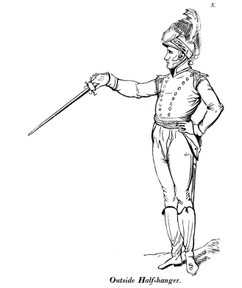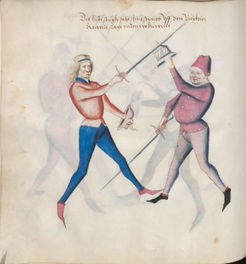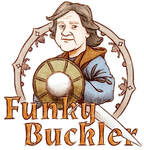|
There are many ways to prepare for Historical European Martial Arts (HEMA) tournaments. Competitors may study from manuscripts and other historical sources in order to learn swordsmanship. These types of competitors can range from people that dedicate themselves to a single system to others that pursue a general study of multiple systems to understand a weapon as a whole. However, studying treatises is not the only way competitors prepare for HEMA tournaments. Others put more emphasis on the physical aspect of tournaments and swordsmanship. They may also take a trial and error approach to learning techniques and tricks that work to aid them in a tournament. At one extreme, the competitors who study the manuscripts bite their thumb at those that ignore the sources. On the other extreme, the competitors who focus on the physical aspect believe that treatises are limiting and prevent fencers from adapting in a fight. Today we will begin a two part series on the advantages, and disadvantages, of studying treatises to prepare for HEMA tournaments. Structure The first and most useful advantage swordsmanship treatises provide is structure. A treatise contains a series of actions, vocabulary, definitions, and other teachable objects that allows for everyone studying the treatise to speak the same language. In the case of British military sabre systems, this is demonstrated with numbered cuts and sequenced plays. (Roworth, 1824) In the case of I.33, it is the terminology and plays that help illustrate techniques to perform. (Manuscript I.33, Early 14th Century (2018)) In Meyer’s longsword system, the sword actions are named to help assist in understand ways the longsword can move. (Meyer, 1570 (2015)) Even loosely structured systems like George Silver’s system contain terms like variable, open, and guardant to define how a fencer is to conduct themselves in different scenarios. (Silver, 1599) This allows for competitors preparing for a tournament to communicate specific techniques effectively and to connect with a larger audience of competitors who also use the treatises to learn swordsmanship. Being able to learn and practice with a larger audience who can reference specific terms and techniques helps grow competitors in their journey in learning swordsmanship. Learning from the Past Another advantage to studying treatises is the ability to learn from the past. In many cases, the treatises come from a history of learning from prior masters which continued to develop and refine what they believed to be the proper way to use their respective weapon. For the Bolognese sidesword and buckler system, Achille Marrozo and Antonio Manciolini learned from the Dardi School of Fencing. (Wiktenauer, 2021) For German longsword sources, there is an entire lineage of sources developed in the Liechtenauer Tradition. (Wiktenauer, 2022) Specifically for the Liechtenauer tradition, the Fellowship of Liechtenauer listed in Paulus Kal’s manuscript contained seventeen individual names that were involved with the development of the system as a whole. Later, Joachim Meyer would continue the Liechtenauer tradition adding even more literature to study and learn from. Even in the cases where there is not a clear lineage like I.33, competitors can learn from the lessons that are taught. These treatises serve as a way at least one person believed a sword should be used. By studying these treatises, modern competitors can learn what worked, and did not work, from previous fencing masters. Closing ThoughtsStudying treatises as described in this blog post is not just reading manuscripts. Drills, peer reviews of techniques, practice, sparring, and other tangible activities are all required to properly study a treatise. However, with practice and a scholarly approach to learning treatises, a fencer can learn to become a competent competitor in HEMA tournaments. There is no doubt in my mind that given enough trial and error, HEMA tournament competitors could re-create the systems written in the treatises. However, by studying the treatises, HEMA tournament competitors can immediately learn practical techniques which can take a bit of the guess-work out of learning swordsmanship. ReferencesManuscript I.33.(Early 14th Century (2018)). (D. J. Forgeng, Trans.)
The Medieval Art of Swordsmanship: Royal Armouries MS I.33 Meyer, J. (1570 (2015)). The Art of Combat. (D. J. Forgeng, Trans.) Roworth, C. (1824). The Art of Defense on Foot with Broad Sword and Sabre. Silver, G. (1599). Paradoxes of Defence. Retrieved from http://www.pbm.com/~lindahl/paradoxes.html Wiktenauer. (2021). Filippo Dardi. Retrieved from Wiktenauer: https://wiktenauer.com/wiki/Filippo_Dardi Wiktenauer. (2022). Johannes Liechtenauer. Retrieved from Wiktenauer: https://wiktenauer.com/wiki/Johannes_Liechtenauer
0 Comments
|
Proudly powered by Weebly




